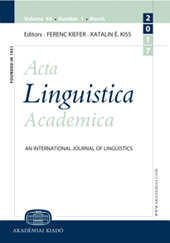Classical Chinese pronouns: Pragmatic implications and politeness
Classical Chinese pronouns: Pragmatic implications and politeness
Author(s): Cher Leng LeeSubject(s): Semiotics / Semiology
Published by: Akadémiai Kiadó
Keywords: politeness; first-person pronouns; Classical Chinese; pragmatic implications; indexicality
Summary/Abstract: Contemporary Chinese has only one form of first-person pronoun; by contrast, there are at least four different first-person pronominal forms used in Classical Chinese. This makes Classical Chinese first-person pronouns noteworthy to investigate. This co-existence of forms with similar meaning of self-referencing raises two issues, namely the reason behind this co-existence and the relationships among these pronominal forms in terms of sociopragmatic use. Unlike what has been previously argued in the field that address forms rather than pronouns are politeness-related (e.g., Kádár 2007; Pan & Kádár 2011), first-person pronominal forms in Classical Chinese express a diverse set of contextually-situated politeness-related meanings. Furthermore, these pronominal forms are socially indexical, in the sense that they are allocated to speakers depending on their social status. Thus, a central argument of this paper is that the pronominal forms studied reveal information about both the person who uses them and the context in which they are used. The paper compares pronominal forms used in the Lunyu 論語 or The analects of Confucius (475 BC–221 BC) and Shishuo Xinyu 世說新語 (A new account of the tales of the world) (200 AD–400 AD), to understand the pragmatic implications and politeness values of these different first-person pronominal forms over a time-span of 400–600 years and also to provide a glimpse of how eventually only one form came to exist in contemporary Chinese.
- Issue Year: 66/2019
- Issue No: 2
- Page Range: 271-288
- Page Count: 18
- Language: English
- Content File-PDF

